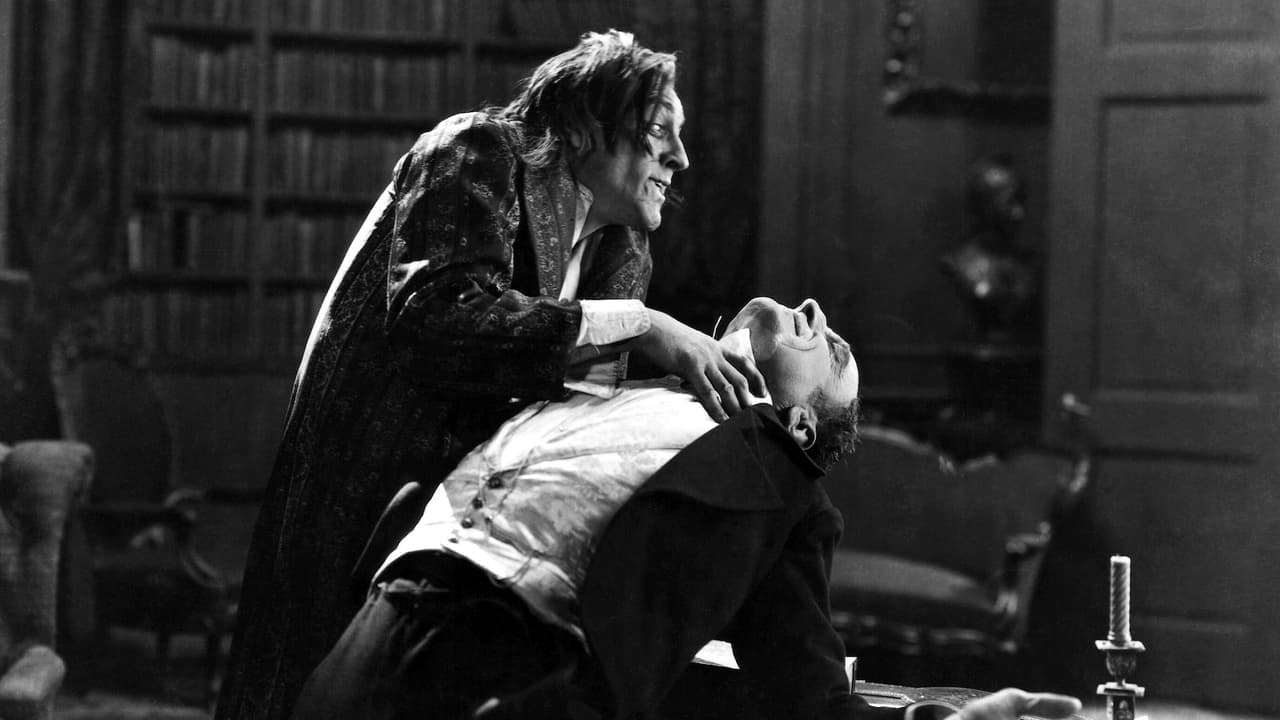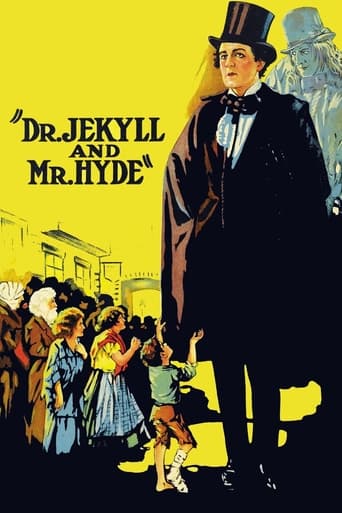

recommended
... View Morean ambitious but ultimately ineffective debut endeavor.
... View Morea film so unique, intoxicating and bizarre that it not only demands another viewing, but is also forgivable as a satirical comedy where the jokes eventually take the back seat.
... View MoreThe joyful confection is coated in a sparkly gloss, bright enough to gleam from the darkest, most cynical corners.
... View MoreThis is the third of 3 silent era versions of this movie I'm seeing--not counting "Dr. Pyckle and Mr. Pride" of course. The other two films, made in 1912 and 1913 were both relatively short, but this film directed by John S. Robertson runs at an hour and twenty two minutes, which in my opinion is a little too long. Some parts of this movie aren't really necessary--I'm not really sure what Miss Gina had to do with the rest of the action and other parts with Mr. Hyde seemed like padding. Then again, I suppose they overdid it a bit just to show off Hyde's physical appearance. As in the other versions, Jekyll here has a girlfriend. Only--and this is interesting--she is the daughter of Sir George Carew, the man who Jekyll later murders as Hyde. He is portrayed as a bad influence to Jekyll and a temptation. In the end, Jekyll can't resist and follows Carew. As a result, he turns into Hyde--and this Hyde here looks amazing, with straight black hair, long nails and fingers, and a lump on his head. The appearance of him is in fact very good and it does seem as though John Barrymore--the actor who played both Jekyll and Hyde--was two different people. Hyde starts then causing trouble and weakening Jekyll's ability to control him, and disastrous results occur.Mostly, the movie is very slow-moving and has some unnecessary parts--what Hyde had to do with two random ladies in a bar is beyond me. However, this is not to say there aren't some good moments: having Jekyll transform into Hyde in front of Carew before murdering him is a nice addition. The ending, also very interesting--Jekyll's girlfriend never actually knows the whole truth. It clearly strays from the novella quite a bit--but then, it improves the story too. Hyde is well portrayed and is probably the better version of all 3 of them.Padded certainly, but otherwise a good movie. Just watch the 49 minute version instead, if you can.
... View MoreRobert Louis Stevenson's story is familiar to most of us. Dr. Jekyll is an altruistic doctor, maintaining a clinic for the poor at his own expense, "the Saint Anthony" of London, a paragon of probity and a pillar of the community. But he's doing some research on drugs that his more conservative friends believe to be dangerous.They point out to Jekyll that every man has dual sides, a buried nature that is bad, even Jekyll himself, and, well, in short, it's not nice to fool around with Mother Nature. The Greeks would have agreed and called it hubris. To demonstrate the animal instincts in Jekyll, his friends take him to a louche dance hall where the seductive Nita Naldi is doing her number on the stage. Jekyll goggles at her and undergoes what he might have called a parasympathetic reflex.Back in his home laboratory, he develops a drug that turns him for a few minutes into an evil-looking creep with long hair, a skull shaped like an ancient Peruvian Indian's, and a face that is going through spasms of theatrical torture, before another dose of the drug returns him to normal. Actually, he kind of liked how it felt to be evil. It's fun to be naughty. So he begins using the identity of Mr. Hyde regularly, hiring a shabby room, consorting with low lifes, and generally embarking on what the titles call "a sea of license" and the less literate of today would call "the hedonistic treadmill." I don't think I want to get into the plot too much further. Let's just say that any man who stomps a child in the street and bashes in the head of his future father-in-law can't be all bad.Stevenson's book was published in 1886 in Victorian England. I don't think the story would have had quite the same impact in any other period. It was such a priggish time. Lamb chops acquired little paper panties, furniture legs were draped with tiny skirts, and roast fowl had "white meat" and "dark meat" instead of b*****s and l**s. Nobody was supposed to have a Mister Hyde buried inside him. Oscar Wilde's "The Portrait of Dorian Gray" was published in 1890 and gave the public a glimpse of another Mr. Hyde. Sigmund Freud didn't invent the unconscious but he was about to popularize it and examine it in detail. He called all those buried animal impulses "das Es" -- "the id." There's a moral lesson here. Before you try your experimental drug on yourself, try it on mice first.
... View MoreThis is the first silent film I've watched since they used to show Charlie Chaplin and Harold Lloyd on the telly before the telly became a huge pile of crap and to be honest with you, they need to show more films like this rather than programmes like 'Real housewives of Accrington', 'Whelk Catchers' and 'The Only Way is Grimsby'. This film was made in what seems like an impossible time ago, 1920, so in our age of information, where we're barraged with noise and data almost everywhere we go, how can a film with no audible dialogue stand up?Actually, it stands up quite well. The copy I had came with a terrible music soundtrack, so instead I watched the film while listening to Aphex Twin's Selected Ambient Works 2. That seemed to work nicely.John Barrowmore is Dr Jekyll, man of the people, helping the poor and spending what marginal time he was with his girlfriend. Trouble is, his mates think he's boring. They think he needs to get out to some bars, hang around with some loose women, and generally blow off some steam. Jekyll seems to take this on board, but, being a man of science, comes up with a plan. If he can become someone else in order to get involved in a bit of debauchery, then he's in the clear guilt wise with his missus. Makes sense, right? Jekyll necks his new formula and before you know it, he's Mr Hyde. Mr Hyde likes his hooch, and likes his women, but he's also as mean as hell. Worse still, he's becoming the dominant personality and folks are noticing that Jekyll doesn't seem to be around that much any more. This might be some allegory on the duality of man and the struggle ever person faces with doing what's good and what's wrong. I don't know much about that, but I sure loved the bit where he stomped on that kid and then paid off the family. Or how about that bit where he beat the guy to death? Or the bit where Jekyll dreams about a genuinely creepy spider-guy crawling up his bed (I wasn't expecting that and was well impressed)?John Barrowmore was pretty good as both characters, going from a pale-faced, innocent Doctor to a gurning, hunched wretch. The film zips by pretty quickly (not much time for long drawn out dialogue in silent films) and has some genuinely unsettling moments, from the spider bit above to the bit in the bar where Hyde man handles two hookers. I was glad I broke my silent movie duck on this one.
... View MoreOne of the early adaptations of Robert Louis Stevenson's famous novel casts John Barrymore as the eponymous doctor whose potion releases his evil side. Specifically, this version has Jekyll curious about the existence of a malevolent personality in every person and wanting to be able to make said personality exist on its own...but, we all know what happens.Early on, I thought that the movie was moving kind of slowly since it seemed like the characters were merely having discussions about Jekyll's experiments. But once the good doc drinks his potion, the fun starts. As can be expected, Hyde is one nasty dude.All in all, "Dr. Jekyll and Mr. Hyde" has truly stood the test of time. A veritable piece of cinema history. Also starring Brandon Hurst, Martha Mansfield and Nita Naldi.
... View More